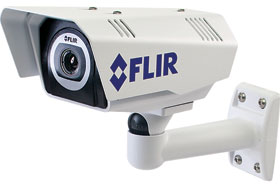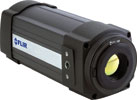

There are advantages and disadvantages to whichever solution or technology is chosen for securing an area. A full risk analysis is critical to ensure that the technology chosen provides optimal results.
Thermal imaging technology has grown in repute, while prices have been reduced to more affordable levels, since its initial introduction in the military sector in 1958. The first infrared camera for commercial applications was developed in 1965 and was used for power line inspections. In 1973, the first portable, battery-operated infrared camera was introduced.
The technology required that the camera was filled with liquid nitrogen to cool down the infrared detector integrated in the system. In 1985, FLIR Systems introduced the first system not requiring liquid nitrogen to cool the detector. This camera used an integrated cryocooler. In 1997, the first thermal imaging camera with an uncooled detector – a microbolometer – was introduced.
Although available at a premium, thermal imaging cameras have a very niche role to play in securing assets. Most security cameras require a secondary light source to provide illumination for effective data capture in the dark. This directly increases the cost of energy usage as well as the cost of the security installation. Thermal cameras, however, do not require a light source and they are able to expose threats hidden in the darkness, concealed by adverse weather, and veiled by obscurants like dust, fog, and smoke.
“There is a huge emphasis on conserving energy annually and given that R1 from every R5 spent globally is used on often inefficient and unnecessary lighting, there is definitely a large role for thermal imaging cameras to play in the security environment,” says Joshua Low, IFSEC SA Event Director at show organiser UBM Montgomery.
In essence, thermal imaging, or thermography, allows one to visualise heat in an image, where different temperatures are represented by different colours. Infrared radiation cannot be seen with the naked eye but thermal imaging converts this infrared radiation, an indication of temperature, into a visual picture that we can see. Thermal imaging is a proactive, non-contact and non-invasive technique that allows us to see what would otherwise have been visible only by using a secondary light source.
“Thermal imaging cameras may also be used for evidence collection. This is especially the case where an object is discarded by a suspect during pursuit. From a fire rescue perspective, thermal imaging can be used to see through smoke to find victims, or to see hot spots in walls before a fire spreads,” Low continues.
On show
A number of exhibitors will be sharing their thermal camera offerings at IFSEC SA 2015.
Since criminal attempts are made in the cover of darkness, Miro’s latest IP thermal surveillance cameras built by Sunell, are an excellent complement to a complete IP surveillance system. Users can access the cameras with a secure Internet connection, even when offsite.
The AXIS Q1932-E’s thermal resolution of 640x480 and a range of lenses make it easy to detect and identify people, objects and incidents. Thanks to a new filter that removes the blur and ghost effects, the images are kept sharp in all conditions.

TeleEye SA, an official distributor of FLIR thermal imaging products says that with the recent Ebola outbreak, there is increasing interest in the A320 Tempscan. These cameras can detect people infected with a viral disease at a very early stage by producing an image that indicates even the smallest temperature differences. The company also distributes the FLIR FC series with on-board video analytics that have the ability to classify human or vehicle intrusions.
Exhibition space can be booked through Sven Riddle on +27 (0)10 003 3077 or email [email protected]. Visit the IFSEC SA 2015 website on www.ifsecsa.com for further information on the exhibition.

© Technews Publishing (Pty) Ltd. | All Rights Reserved.